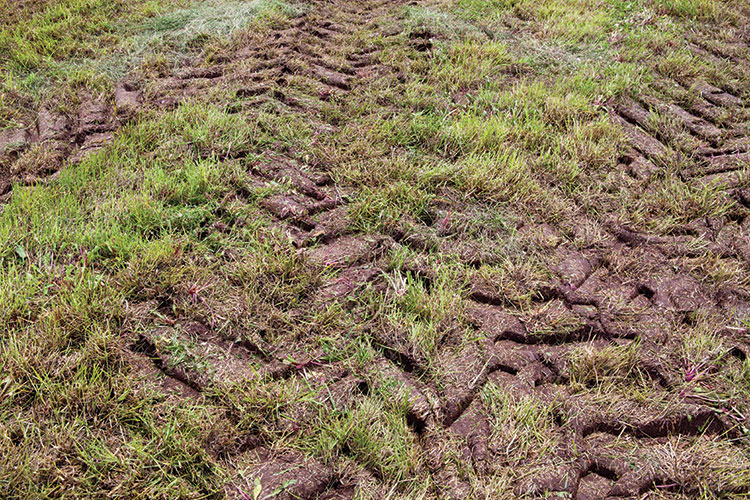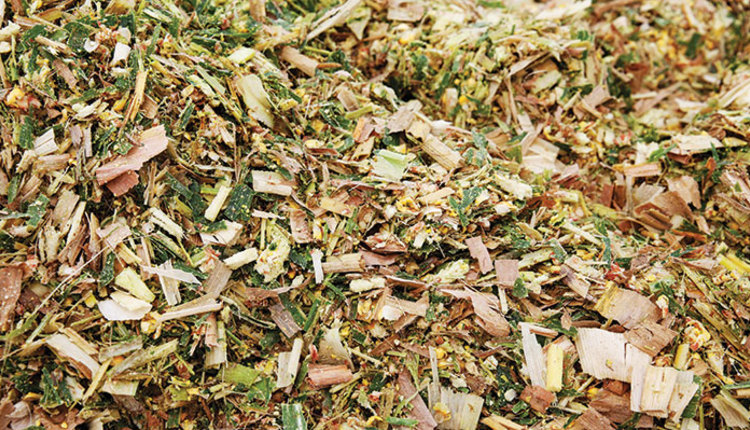
Soils are the lifeblood of crop production, and healthy soils are critical to maximize forage and grain yields on the dairy farm. More and more, wet spring and fall weather contributes to soil compaction potential as growers drive heavy tractors, manure tanks, and harvest equipment on wet soils. Soils are most sensitive to compaction when they are in a plastic state — when you can make a ball out of soil in your hand.
Soil compaction is a leading cause of poor crop growth since it changes the physical, chemical, and biological characteristics of the soil. These changes include reduced porosity (fewer and smaller spaces between soil particles) and a resulting elevation in soil bulk density (more weight in the same volume).
When soils become compacted, they have lower water percolation and infiltration, and roots have a harder time growing and penetrating compaction layers, which can lead to greater drought susceptibility. From a fertility standpoint, soil compaction can reduce availability of key nutrients like phosphorus and potassium since they are relatively immobile in the soil. Compacted soils limit root growth and nutrient uptake, leading to reduced yield potential or greater disease or lodging potential.
Locate trouble spots
Identifying soil compaction requires some infield work. Penetrometers help locate a specific zone or layer of high resistance and compaction. Our favorite tool is a good old-fashioned hand spade, preferably a straight, square-tipped one which easily penetrates wet clay soils and cuts through roots.
Using your spade, dig out some roots to see if they are growing in a distinct layer or growing horizontally. Also, dig a mini soil pit to observe the soil structure for unusual differences and to help identify the depth of any tillage layers.
Finally, go around the field to see how widespread compaction issues may be. Lower, wet areas may be worse since they are slower to drain. Look for areas of poor crop growth. If compaction is limited to head rows or localized spots, then only address those specific areas when trying to reduce soil compaction.
Repair the damage
The depth of compaction determines the approach and tools used to help mitigate the situation. Soil compaction in the top layer (1 to 5 inches deep) requires limited remediation activity since in the northern U.S., this layer is exposed to freeze-thaw cycles.
Smooth out or fill in shallow ruts and other uneven areas of a field, but limit the burial of crop residue and use a cover crop or rotate to a deep-rooted crop like alfalfa where feasible to help rebuild soil structure and biological activity. Deeply rutted areas may require tilling at right angles to the rut to help with water infiltration at the bottom of these ruts.
In areas where compaction is found deeper than 5 inches, plan to use deep tillage equipment to penetrate and fracture the compacted zone. Only attempt deep tillage when soils are dry to avoid compounding your problem. This is often in the fall of the year in more humid climatic zones. Deep-rooted crops such as alfalfa, clover, or brassica can also be effective in alleviating deep compaction over time.
After subsoiling, the goal is to have a plan to avoid future soil compaction and to build soil structure. Start with your equipment — use flotation tires or tracks on equipment and reduce tire pressure as much as possible to benefit from a large footprint. Do not exceed axle loads of 10 tons, and limit repeated traffic to select areas of the field. Work to minimize soil tillage passes on every field.
When seeding corn into wet soils, adjust your planter to avoid sidewall and closing wheel compaction. Sometimes waiting to till or seed until the afternoon is the right thing to do to give soil a chance to dry out. Finally, plant cover crops to bolster root mass in the surface and subsoil and rotate crops with different root architectures, such as tap-rooted and fibrous-rooted crops.
The path forward
A soil system is living and dynamic, with a propensity to be resilient and heal itself. Weather cycles of wet-dry or freeze-thaw and soil particles, which shrink and swell, help reduce compaction. Earthworms burrow deeply through the soil, helping to redistribute organic matter and create channels for water infiltration. Fungi and other microorganisms growing on or near roots assist in restoring soil structure. Healthy and resilient soils help to ensure we can grow high-quality feed for our dairy cows.










